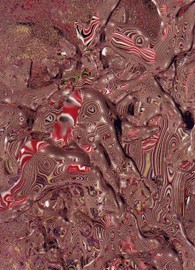 Yoishiro Kawaguchi's Mutation (1992) and
Cell: Artificial Life Metropolis (1993) differ from his early
3D computer art in their multifariously colored textures, their use
of new malleable, liquid forms, and their folding,
enveloping, mutating surfaces. Kawaguchi's recent animations appear
to be reflections of Deleuze's reading (1993) of the mathematics of
liquid folds, his study of infinite curvilinear forms.
Kawaguchi's 3D animations move by algorithms that simulate fluid and
elastic folding surfaces. Deleuze describes how the coherent parts
of fluid and elastic 3D bodies form folds such that when they
are continually divided to infinity in smaller and smaller pleats
and compressions of time and space, they always maintain their
cohesion. Reflecting on the geophilosophy of ripples, waves and the
surface crests of turbulent water, Deleuze defines matter as having
a porous, spongy or cavernous texture that can be surrounded and
penetrated by increasingly vaporous flows and waves of fluid. Like
Kawaguchi's liquid constructions, Deleuze suggests that the
folds of natural geography, of water, winds and veins of metal ore,
resemble the curves of conical forms that sometimes transfigure into
hyperbolas or parabolas.
Yoishiro Kawaguchi's Mutation (1992) and
Cell: Artificial Life Metropolis (1993) differ from his early
3D computer art in their multifariously colored textures, their use
of new malleable, liquid forms, and their folding,
enveloping, mutating surfaces. Kawaguchi's recent animations appear
to be reflections of Deleuze's reading (1993) of the mathematics of
liquid folds, his study of infinite curvilinear forms.
Kawaguchi's 3D animations move by algorithms that simulate fluid and
elastic folding surfaces. Deleuze describes how the coherent parts
of fluid and elastic 3D bodies form folds such that when they
are continually divided to infinity in smaller and smaller pleats
and compressions of time and space, they always maintain their
cohesion. Reflecting on the geophilosophy of ripples, waves and the
surface crests of turbulent water, Deleuze defines matter as having
a porous, spongy or cavernous texture that can be surrounded and
penetrated by increasingly vaporous flows and waves of fluid. Like
Kawaguchi's liquid constructions, Deleuze suggests that the
folds of natural geography, of water, winds and veins of metal ore,
resemble the curves of conical forms that sometimes transfigure into
hyperbolas or parabolas.
Mutation follows the metamorphosis of highly
abstract objects that flow, fold and fragment into innumerable
permutations. In Cell, Kawaguchi experiments with liquid
architectures as he builds a fugitive, molten megopolis of
artificial life. These 3D animations epitomize Kawaguchi's work
during the 1990's. Regarding form, his art is also an expression of
the hyperbolic geometry of curving surfaces and of a modulating,
synthesizing, liquid architecture capable of representing
elastic or deforming topological constructions in 3D cyberspace.
Like Malevich's architectones, Kawaguchi's 3D animations
extend formalism's concern with form, surface and texture to include
the language of abstract topology and folding surfaces.
As if he has Kawaguchi's work in mind, Novak (1991)
describes the unusual transformations in the liquid
architecture of cyberspace as the artist or animator generates and
varies objects in time. He perceives cyberspace as a modulating,
artificial architectural space. Liquid, visionary architectures
offer an excess of possibilities in shape, contour, texture and
topological construction. Novak suggests that we can now draw a
comparison between sculpture and computer constructions, because
liquid architectures, like hybrid abstract sculptures, produce
aesthetic beauty or sublimity, structure or lack of structure,
weight or weightlessness, lavishness (expense) or economy, details
or simplicity, uniqueness or universality.
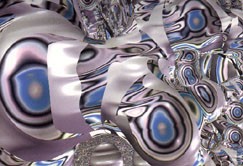 Kawaguchi's Mutation (1992) is a liquid,
morphing 3D meditation on the endless repetition of "biocosmic"
ideas in action. Kawaguchi uses growth algorithms and elaborate,
multilayered textures to visualize the fluidity of changing,
artificial, biomorphic shapes and creatures that exist at the
interstices of microbiology and computer code. He speaks to the
collapsing boundaries between art and science. Mutation
invokes visual impressions of conceptual art, geometric abstraction
and pattern painting, but its spatial structures actually reflect
the recursion, repetition and randomness of computer growth
algorithms in operation. Kawaguchi's "growth model" is a dynamic,
non-deterministic process that allows constructive mathematics to
take its course; a recursive structure of simple rules within
complexity.
Kawaguchi's Mutation (1992) is a liquid,
morphing 3D meditation on the endless repetition of "biocosmic"
ideas in action. Kawaguchi uses growth algorithms and elaborate,
multilayered textures to visualize the fluidity of changing,
artificial, biomorphic shapes and creatures that exist at the
interstices of microbiology and computer code. He speaks to the
collapsing boundaries between art and science. Mutation
invokes visual impressions of conceptual art, geometric abstraction
and pattern painting, but its spatial structures actually reflect
the recursion, repetition and randomness of computer growth
algorithms in operation. Kawaguchi's "growth model" is a dynamic,
non-deterministic process that allows constructive mathematics to
take its course; a recursive structure of simple rules within
complexity.
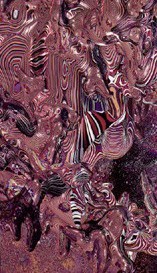 The fluid, seemingly part-serpentine, part-liquid
undulations of Mutation's artificial forms resemble the
movement of sand on the ocean's floor, the simulation of wave motion
or lava flow, or the ripple effects of water after an object's
touch. The radiating, shimmering texture surfaces on the abstract
objects are the composites of animated form, watery rippling
surface, manifold color, reflection and refraction. The
simulationist computer compositing and inflection of multilayered
texture maps using ray tracing techniques in 3D animation embody the
computer artist's concern with enfolded, planar or other elastic
topological surfaces in 3D cyberspace; the seamless, modulating,
liquid architecture of complex topological forms in digital
realms.
The fluid, seemingly part-serpentine, part-liquid
undulations of Mutation's artificial forms resemble the
movement of sand on the ocean's floor, the simulation of wave motion
or lava flow, or the ripple effects of water after an object's
touch. The radiating, shimmering texture surfaces on the abstract
objects are the composites of animated form, watery rippling
surface, manifold color, reflection and refraction. The
simulationist computer compositing and inflection of multilayered
texture maps using ray tracing techniques in 3D animation embody the
computer artist's concern with enfolded, planar or other elastic
topological surfaces in 3D cyberspace; the seamless, modulating,
liquid architecture of complex topological forms in digital
realms.
Like tangible, plastic, but less durable kinds of
digital architecture and construction, modernist artists of the past
also invented entire worlds without explicit reference to explicit
reality. For example, Malevich's architectones combine flat
and curved surfaces with round and rectilinear forms in three
dimensions and in ways that refuse symmetry. Curving non-Euclidean
forms are combined with Euclidean geometric shapes and spatial forms
(squares, cubic volumes and parallelograms) as to constitute the
basis for a new vocabulary of visual signs. Each architectone
is assembled from the artist's intuitive elements and not according
to mathematical formulas, as was the case with the contemporary work
of the De Stijl neoplastic movement. Mondrian, Malevich, Klee and
Kandinsky thus prefigure or antecede folding, liquid architecture,
but the similarities are sometimes astonishing. If we wonder, what
would life be like inside a cubist universe or a Magritte trompe
l’oeil, then we may find the answer inside Kawaguchi's
Mutation.
 In Cell: Artificial Life Metropolis (1993),
Kawaguchi seems to take the idea of a folding, liquid architecture
more literally as he constructs a transmogrifying metropolis of
fluid skeletons and spines. He experiments with helixes and
mini-spirals that form aggregates of slippery, metallic caverns,
plateaus, and long columns of coils that snake like household
electric wire around cyborgian structures. The observer is unsure
whether she is journeying through a robotic body, or witnessing the
cool blue tectonic plate movement of some alien geological forms.
Like Haraway's cyborg figures (1985, 1997), Kawaguchi's artificial
creatures are hybrids of machine and organism, techno-genetic bodies
capable of "mating" by exchanging genetic and technical material so
that new configurations can emerge within the virtual arena. These
artificial figurations are important in delineating the ontological
nature of virtual worlds as they pertain to topological
representation and simulated visual forms. Following Eisenman
(1993), the enveloping surfaces of The Cell also hold the
potential for future cyberspace architectures derived from planar
folds and 3D volumes.
In Cell: Artificial Life Metropolis (1993),
Kawaguchi seems to take the idea of a folding, liquid architecture
more literally as he constructs a transmogrifying metropolis of
fluid skeletons and spines. He experiments with helixes and
mini-spirals that form aggregates of slippery, metallic caverns,
plateaus, and long columns of coils that snake like household
electric wire around cyborgian structures. The observer is unsure
whether she is journeying through a robotic body, or witnessing the
cool blue tectonic plate movement of some alien geological forms.
Like Haraway's cyborg figures (1985, 1997), Kawaguchi's artificial
creatures are hybrids of machine and organism, techno-genetic bodies
capable of "mating" by exchanging genetic and technical material so
that new configurations can emerge within the virtual arena. These
artificial figurations are important in delineating the ontological
nature of virtual worlds as they pertain to topological
representation and simulated visual forms. Following Eisenman
(1993), the enveloping surfaces of The Cell also hold the
potential for future cyberspace architectures derived from planar
folds and 3D volumes.
In a similar way, the work of Uri Dotan, computer
artist, in homage to 1960's painter Frank Stella, epitomizes the new
synthetic possibilities of virtual space as the complex creative
expression of expanded computer code in modeling, lighting, ray
tracing and transparency. The complex geometry of curved abstract
shapes elaborated in contrapuntal, curving, liquid 3D forms,
and in combination with heavy texture mapping, draws attention to
surfaces that both reflect and distort the virtual reality around
them. Dotan's digital pieces appear to be the simulacra of the
unseen, reminiscent but unlike objects in nature. Like Kawaguchi's
biocosmic constructions, they belong to no "real" space but to
hermetic, alternative worlds.
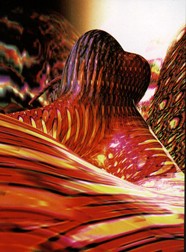 Returning to Kawaguchi's liquid figurations, his
recent work did not appear overnight, but are the offspring of many
years of tweaking and amplifying his growth model. His earliest
animation work, Pollen (1975) and Lines (1976)
duplicate the rotating movement of dotted lines and spirals
reminiscent of Gabo's work in plastic fibers from the 1920s and
1930's. Shells (1976), a prototype of the auto-multiplying
growth algorithm, animates the delicate, soft extrusion of hollow
wire-frame conch shells, horns and cones. In Growth: Mysterious
Galaxy (1983), Kawaguchi introduces some new organic structures,
such as his embryonic dolphins of liquid space, his red and green
metallic tendrils, and his pink undersea chorals. He elaborates the
play between surface and liquid submersion in Ocean (1986) as
tubular, twisted helixes wind around flourescent green undulating
ocean floors. Ocean also cameos Kawaguchi's first use of
ornate, reflective surface textures. Float (1987) follows the
voyage of unknown, perfectly golden, multifaceted globules through
luminous organic whirlpools.
Returning to Kawaguchi's liquid figurations, his
recent work did not appear overnight, but are the offspring of many
years of tweaking and amplifying his growth model. His earliest
animation work, Pollen (1975) and Lines (1976)
duplicate the rotating movement of dotted lines and spirals
reminiscent of Gabo's work in plastic fibers from the 1920s and
1930's. Shells (1976), a prototype of the auto-multiplying
growth algorithm, animates the delicate, soft extrusion of hollow
wire-frame conch shells, horns and cones. In Growth: Mysterious
Galaxy (1983), Kawaguchi introduces some new organic structures,
such as his embryonic dolphins of liquid space, his red and green
metallic tendrils, and his pink undersea chorals. He elaborates the
play between surface and liquid submersion in Ocean (1986) as
tubular, twisted helixes wind around flourescent green undulating
ocean floors. Ocean also cameos Kawaguchi's first use of
ornate, reflective surface textures. Float (1987) follows the
voyage of unknown, perfectly golden, multifaceted globules through
luminous organic whirlpools.
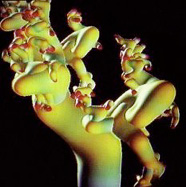 As testament to Kawaguchi's widely-recognized,
distinctive style, Festival (1991) features a marine carnival
of sea urchins, choral, sea amoeba and other fractalized
creatures. Surface textures are now so multifarious and fugitive
that they transgress the boundaries of the sublime or indescribable.
Kawaguchi's folding, liquid architecture is consequently a
dematerialized, ethereal, modulating architecture that is not
satisfied with space, form, light, weight, etc. in the physical,
bodily world, but corresponds to the merging or diverging of
abstract topological objects and elements in mind spaces.
As testament to Kawaguchi's widely-recognized,
distinctive style, Festival (1991) features a marine carnival
of sea urchins, choral, sea amoeba and other fractalized
creatures. Surface textures are now so multifarious and fugitive
that they transgress the boundaries of the sublime or indescribable.
Kawaguchi's folding, liquid architecture is consequently a
dematerialized, ethereal, modulating architecture that is not
satisfied with space, form, light, weight, etc. in the physical,
bodily world, but corresponds to the merging or diverging of
abstract topological objects and elements in mind spaces.
Rewriting formalism: abstract form in hybrid new
media
The formalists of the 1960's, Greenberg (1967),
Fried (1995), Krauss (1968), and Rose (1967), also express some
interest in how the 3D sculptural event in "real" Cartesian space
creates spatial metaphors between objects. In "Sculpture in Our
Time," Greenberg (1958) suggests that we permit sculpture greater
latitude of figurative allusiveness than other media, because it
remains tied to the third dimension. The illusion of organic
substance or texture is analogous to 3D in pictorial perspective
(such as that in 3D graphics or canvas arts) and, Greenberg
continues, this illusionism, literalness, or conceptual
content has become an advantage rather than a hindrance.
Greenberg chooses the sculptures of Jules Olitski as an epitome of
modernist abstraction, because they create the illusion of capturing
and folding surfaces of color in 3D space, an effect that seems to
render them weightless. Instead of the illusion of things, they
offer us the illusion of modalities, namely that matter is
incorporeal and weightless.
Greenberg emphasizes the radical
abstractness, or unlikeness to nature of Olitski's work (a
frequently used euphemism in the 1960's), and the "weightlessness"
of his sculptures in the way he says that they resemble Alexander
Calder's mobiles. "Weightlessness" is a term from abstract art that
implies free movement and a sense of not being grounded.
Weightlessness and modality are the basis of formalism's new
illusionism where matter is weightless and corresponds to some
non-Euclidean algebraic geometric space not unlike cyberspace.
Again, this kind of weightlessness belongs to the tradition of
non-monolithic sculpture that we derive from cubist collage and with
a cerebral and not a physical understanding of 3D form. Some
critics, such as Krauss (1968), carry the cubist metaphor of
illusionism to extreme conclusions: optical illusion becomes
tactile opticality, sensuous to touch, as Krauss pushes the
micrological analysis of the grain of sculptural surfaces to
inordinate refinements.
Picasso's cubism indulges in and extends
non-Euclidean paradigms of rounded or curved spaces in
discontinuous, fractured collages. While Poincaré wrote about the
tactility of curved space, Picasso's cubism enabled the radical
materialization of this new space. Mondrian points out that cubism
brings art to the threshold of a break with nature: It loses its
unity by expressing the fragmented character of the appearance of
objects. The tragic in nature is manifest as corporeality,
and this is expressed plastically as form and color, as
curvature and the "capriciousness" and irregularity of surfaces.
Similarly, Deleuze (1993) discusses the importance of the
plastic fold by showing us that matter is folded twice, once
under elastic forces (of water, wind, ore, or magma), and a second
time under plastic, derivative, organic and machinic forces.
Folding-unfolding can no longer be equated to tension-release, or
contraction-dilation, but to enveloping-developing and involution
evolution. The plastic organism is defined by its ability to
fold and unfold its own parts, not to infinity, but to a degree of
development inherent in its species. In the theory of non-Euclidean
curving surfaces, Deleuze distinguishes elastic forces from plastic,
"machinelike" forces that are present in modernist culture and
artifice, including the curving, pleated color surfaces of Olitski's
abstract sculpture.
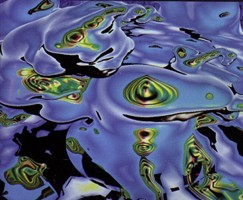 Oliski's folding color surfaces defy the
literalness of edge and boundary. There appear to be no broken
surfaces. Greenberg writes, the grainy, tactile surfaces of color
contrive an illusion of depth as if those surfaces expand to contain
a "world of color" and light differentiations impossible to
flatness, but manage in some way not to violate flatness. Olitski's
"free" shapes and contours perhaps constitute the first attempt in
the history of art to realize pure color in three dimensions. Color
does not merely lie on Olitski's hybrid surfaces, but creates a new
kind of enriched surface and new spatial relationships. Resembling
Kawaguchi's molten configurations, each surface becomes a total
field of shape and form that avoids the determinate edges of the
rectangle in its flowing, folding convolutions. Olitski ability to
identify fluctuations of color value and hue makes spatially
developed 3D figures appear like shaped color (as opposed to
mere colored sculpture). Consequently, we may view his work in
hybrid pleated surfaces as a precursor to Kawaguchi's multiple
surface permutations.
Oliski's folding color surfaces defy the
literalness of edge and boundary. There appear to be no broken
surfaces. Greenberg writes, the grainy, tactile surfaces of color
contrive an illusion of depth as if those surfaces expand to contain
a "world of color" and light differentiations impossible to
flatness, but manage in some way not to violate flatness. Olitski's
"free" shapes and contours perhaps constitute the first attempt in
the history of art to realize pure color in three dimensions. Color
does not merely lie on Olitski's hybrid surfaces, but creates a new
kind of enriched surface and new spatial relationships. Resembling
Kawaguchi's molten configurations, each surface becomes a total
field of shape and form that avoids the determinate edges of the
rectangle in its flowing, folding convolutions. Olitski ability to
identify fluctuations of color value and hue makes spatially
developed 3D figures appear like shaped color (as opposed to
mere colored sculpture). Consequently, we may view his work in
hybrid pleated surfaces as a precursor to Kawaguchi's multiple
surface permutations.
Also, in a rare moment of self-criticism, Greenberg
admits that he may have been altogether wrong about sculpture and 3D
art, that "construction-sculpture," or "drawing-in-space sculpture"
in the late modernist period is making itself felt as the most
representative, fertile visual art of our time. Its no short
leap to the assumption that Greenberg permitted mixed-media hybrids
to salvage formalism in the 1960s, which later gave birth to its
left branch alternatives in postmodern and simulation art. As
Thierry de Duve (1996b) concludes from his study of 1960's art
polemics, two dimensionality is the last specific refuge of
modernist painting, but three dimensionality is the domain of the
new, generic, hybrid arts.
The theory of folding surfaces in Kawaguchi's
recent work
In Mutation (1993), Kawaguchi's color
surfaces seem to emit their own space and light within themselves
(enfolding space and light), rendering them eerily weightless. This
effect of enfolding, then unfolding space and light (of disposing
forms in space) is partially the result of Kawaguchi's subtle
chiaroscuro hue and shading, which produces an added
illusiveness. Deleuze describes the chiaroscuro effect, the
way the folding surface catches illumination and varies according to
the hour and the light of day, as a function of the fold of matter
and texture itself. Following Leibniz, Deleuze affirms that the fold
affects all materials (metal, paper, fabrics, water, living tissue,
the brain), because it determines and materializes form, becoming
"expressive matter" with different scales, speeds and vectors. Since
folding and the chiaroscuro effect are Baroque traits,
Kawaguchi's folding, pleating surfaces of color can be said to
resemble the overlaying folds and depths (crevices) of fabric or
paper. Deleuze defines three types of inflection of the fold: 1) the
ogive, or the pointed arch, that expresses the lines and
valleys of flowing liquid, 2) the morphological forms of living
matter, such as the dovetail, the butterfly and the hyperbolic or
parabolic umbilicus, and 3) the vortical inflection of the
variable curve, such as Koch's Baroque curve, that opens up on
infinite fluctuation and permutation. The pattern of contraction of
the latter complex spiral folds follows a fractal mode by
which new turbulences are inserted between the initial ones. In its
extreme form, the growing turbulence of folding ends in a "watery
froth" and the erasure of recognizable contour. As Deleuze says, the
Baroque is an "operative function" or "trait" which endlessly
produces folds, then twisting, turning, and pushing them into
infinity, fold over fold, one on the other.
Kawaguchi's abstract forms are therefore elastic
bodies in space whose cohering parts that form a fold, or a multiple
modulating surface of color. The fold does not appear to be
separated into parts, but may be divided into an infinity of smaller
and smaller folds (an endless folding, a 3D origami form). Baroque
folding and chiaroscuro effects become an aesthetics for a
kind of liquid architecture of 3D objects and spaces whose goal is
curvilinearity, the twisting line, the fluidity of matter and
the elasticity of bodies.
Whether they are found in abstract sculpture, the
contours of nature, or 3D simulated cyberspace, Deleuze (following
Leibniz) likens these complex folding interactions (inflections) to
the solid pleats of a "natural geography": the curves of conical
forms that sometimes end in a circle or an ellipse, or sometimes
stretch into a hyperbola or a parabola (1993, p. 6). He may also be
drawing on the continuing twentieth century interest in the curved
spaces of non-Euclidean geometries (such as Beltrami's hyperbolic
geometry) and new fractal geometric models. Eisenman (1993) is
inspired by Leibniz's turn away from Cartesian rationalism and in
his depiction of the point of the fold as the smallest element in
the labyrinth of the continuous. Eisenman also acknowledges Deleuze
for articulating a possible new relationship between vertical and
horizontal, figure and ground, breaking up the existing Cartesian
order of space in digital worlds.
Eisenman identifies Gilles Deleuze and René Thom as
the two most important contemporary theorists of folding surfaces.
Deleuzean extension is the outward movement of objects or
events along the surfaces of planes, rather than downward in depth.
Meaning is found at the surface; deep essences do not define forms.
Eisenman recounts how Deleuze conceptualizes the idea of the surface
object/event in the objectile, a contemporary technological
object such as any object that inhabits 3D cyberspace. The surface
object goes beyond the static framing of space: it necessarily
includes the temporal and topological variation of matter.
Similarly, in Thom's mathematics, the variable
curvature of the fold/unfold is the inflection of the pure event.
Transformations of objects or events do not occur according to a
privileged plan of projection, but instead are modeled by the
neutral surface formed from a variable curvature or fold. A complex
folding and unfolding can explain abrupt changes in form, which can
even be used to explain sudden or catastrophic events. Eisenman
explains, while a tiny grain of sand can trigger a landslide, we
already see the conditions leading up to the moment of movement to
be in place in structure or form. The fold in this sense contains
aspects of both figure and ground, but cannot be reduced to the
singular existence of figure or ground by itself. In a media age,
the changing surfaces of 3D objects in cyberspace are never
meaningful as static entities, but in their timely interaction in
configuration with one another.
The formalists' concern with the form, contour,
texture and relationality of flat and enfolded 2D surfaces is
extended in Kawaguchi's 3D animations, where curving, hyperboloid or
other stretchable or deformed topological surfaces emerge and take
shape. Folds and hyperbolas comprise the substance of
transformations and inflections of objects and events in 3D computer
architecture; a modulating, synthesizing, liquid architecture
capable of representing abstract constructions in digital, symbolic
spaces. Deleuze suggests that the "fold" is a series of convergent
points, or events, on a liquid surface, affirmed by
difference. In The Logic of sense, Deleuze (1990) discusses
how the ancient Epicureans failed to understand the quasi-causal
nature of folding surfaces; they failed in developing their theory
of envelops and surfaces, because they did not reach the idea of
incorporeal effects. Their simulations remained subject to the
single causality of bodies in depth. The Cynics and Stoics, however,
learned that sense appears and is played out on the metaphysical
surface of ideas, in the topological field of singularities,
representations, pure events and paradoxes. Meaning resides on the
surfaces of abstract objects and spaces, on the level of
appearances.
Consequently, both ideas and their effects are
superficial in simulationist new media that express seriality
and reproduction: The "depth" of meaning is realized on the surface
in the domain of visual, auditory and tactile representations, just
as the three-dimensional space is represented in a two dimensional
image or projection, which once flattened, can be mapped/morphed
from object to object in 3D rendering. Kawaguchi's 3D computer art
centers on a pure physics of surfaces, whereby events of a liquid
surface depend on digital transmutations on the level of code, in
auto-multiplying growth algorithms, but also on variations of a
surface appearance of the simulated, ideational quasi-cause. His
emphasis on surfaces translates consequently into a strong reliance
on image mapping and ray tracing techniques to create
photorealistic, 3D effects in his completed work or sequence.
 Kawaguchi's liquid, biocosmic emanations also
appear to be 3D representations of machine, biology and computer
code. They seem to epitomize and embody Deleuze and Guattari's
(1987) innovative and far-reaching revaluation of the
machine/organism distinction in which the "machinic" is opposed to
both the mechanical and organic to allow for complex, open-ended
becomings within evolution. A truly "machinic" conception of
creative evolution must embrace a radical pluralism of technical,
semiotic, axiomatic and other machines that avoids the positing of
the "human" and the reified, humanized notion of what constitutes
autonomy on the machine. Perhaps Kawaguchi's animations are the
earliest attempts to meet Deleuze and Guattari's "machinic"
vision.
Kawaguchi's liquid, biocosmic emanations also
appear to be 3D representations of machine, biology and computer
code. They seem to epitomize and embody Deleuze and Guattari's
(1987) innovative and far-reaching revaluation of the
machine/organism distinction in which the "machinic" is opposed to
both the mechanical and organic to allow for complex, open-ended
becomings within evolution. A truly "machinic" conception of
creative evolution must embrace a radical pluralism of technical,
semiotic, axiomatic and other machines that avoids the positing of
the "human" and the reified, humanized notion of what constitutes
autonomy on the machine. Perhaps Kawaguchi's animations are the
earliest attempts to meet Deleuze and Guattari's "machinic"
vision.
Kawaguchi certainly provides a topological,
probabilistic and irrational animation space for his modulating
folds and 3D forms. Each of these liquid volumes constructs with the
others a noospheric "circulation" and a "cinema" of thought. Like
philosophy, Deleuze believes that the interactive, animated cinema
is a conceptual practice: In its twisting, folding and fissuring of
digital, informatic substance, it constructs and discovers new
pathways, connections and concepts. Although corporeal depth is
important, Deleuze believes that each thing is inscribed, sublimated
and symbolized on the liquid, noematic and metaphysical
surface, the "second screen" or realm of informatics that "hovers"
over bodies. He recognizes the brain as the "inductor" of that
second, invisible, cerebral, parabolic, metaphysical surface on
which all events fold and unfold. Thought brings about the
projection, conversion and induction of a physical folding surface
into a metaphysical surface; the projection in fact transmutes a
Euclidean space into an abstract, topological space. Kawaguchi's
recent animations, Mutation and Cell, confirm
Deleuze's belief that creating new connections in art means creating
them in the mind too!
Works Cited
Armstrong, M. A. Basic Topology. New York: Springer, 1983.
Benedikt, Michael, ed. Cyberspace: First Steps. Cambridge, MA: MIT Press, 1991.
Carroll, Noel. "Anti-illusionism in Modern and
Postmodern Art." Leonardo 21 (1988): 297-304.
Crary, Jonathan. Techniques of the Observer: On
Vision and Modernity in the Nineteenth Century. Cambridge, MA:
MIT Press, 1990.
Deleuze, Gilles. Negotiations: 1972-1990. New York: Columbia University Press, 1995.
- - - . The Fold: Leibnitz and the Baroque. Trans. Tom Conley. Minneapolis: University of Minnesota Press, 1993.
- - - . The Logic of Sense. Trans. Mark Lester and Charles Stivale. New York: Columbia University Press, 1990.
Deleuze, Gilles and Felix Guattari. A Thousand
Plateaus: Capitalism and Schizophrenia. Trans. Brian Massumi. Minneapolis: University
of Minnesota Press, 1987.
De Duve, Thierry. Clement Greenberg between the
Lines. Paris: Éditions Dis Voir, 1996a.
- - - . Kant after Duchamp. Cambridge, MA: MIT Press, 1996b.
Eisenman, Peter. Reworking Eisenman. London: Academy Editions, 1993.
Fried, Michael. "Two sculptures by Anthony Caro."
Artforum 2 (1968): 24-5.
- - - . "Shape as Form: Frank Stella's New Painting."
Artforum 11 (1966): 18-27.
- - - . "Art and Objecthood." Minimal Art: A Critical Anthology. Ed. Gregory Battcock. Berkeley: University of California Press, 1995. 116-147.
Greenberg, Clement. Collected Essays and
Criticism, Volume 4: Modernism with a Vengence, 1957-1969.
Chicago: Chicago University Press, 1993a.
- - - . Collected Essays and Criticism, Volume 3:
affirmations and refusals, 1950-1956. Chicago: Chicago University Press, 1993b.
- - - . "Recentness of sculpture." Art
International 4 (1967).
- - - . "Contemporary sculpture: Anthony Caro." Studio
International 9 (1965).
- - - . "Post painterly abstraction." Art
International (Summer 1964).
- - - . Art and Culture: Critical Essays. Boston:
Beacon Press, 1961.
- - - . "Sculpture in our time."
Arts Magazine 6 (1958).
Haraway, Donna. Modest_Witness@Second_Millenium.
FemaleMan©_Meets_OncoMouse™: feminism and technoscience. New York: Routledge, 1997.
- - - . "Manifesto for Cyborgs: Science, Technology and Socialist Feminism in the 1980s." Socialist Review 80 (1985): 65-108.
Krauss, Rosalind. The Originality of the
avant-garde and other modernist myths. Cambridge, MA: MIT
Press, 1996.
- - - . "The Essential David Smith." Artforum 2 (1969): 43-9.
- - - . "On Frontality." Artforum 5
(1968): 40-7.
Mondian, Piet. The New art-the new life:
collected writings. London: Thames and Hudson, 1987.
Novak, Marcus, "Liquid architectures in cyberspace." Cyberspace: first steps.
Ed. Michael Benedikt. Cambridge, MA: MIT Press, 225-54.
Rose. Barbara. "Abstract illusionism." Artforum 10 (1967): 33-37.
- - - . "How to murder the avant-garde." Artforum 4 (1965a): 30-34.
- - - . "Looking at American sculpture." Artforum 3 (1965b): 33-41.
Shearer, Rhonda. "Chaos Theory and Fractal
Geometry: Their Potential Impact on the Future of Art." Leonardo 25 (1992): 143-52.

 About the
Author
About the
Author Table of
Contents
Table of
Contents